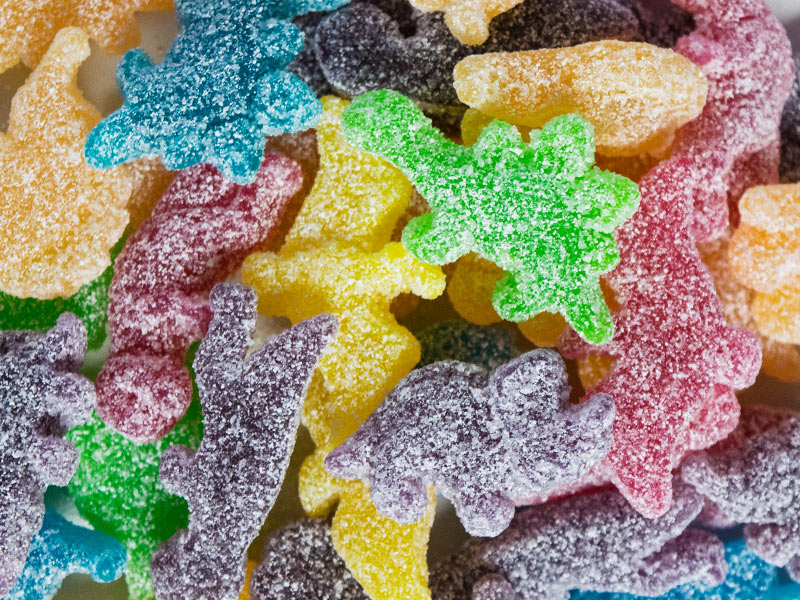Trick or Treat?
Family outings are one of the perks of being a parent. Museums, farms and adventure parks are double the fun with an inquisitive 8-year-old in tow. Is there a downside to these events? Truth be told, there are plenty. However, none can match up to the disappointment of child-friendly catering. Take, for example, the Natural History Museum in London. One whiff of their dismal kiddy cuisine and we were scuttling off to the neighbouring V&A for a ‘proper’ lunch! A dinosaur-themed eatery might be in-keeping with the museum’s subject matter, but the odours emanating from within were more reminiscent of Leicester Square’s street vendors on a Saturday night. Acceptable student fodder after a skinful at the club, but hardly nutritious fayre for growing kids. I struggled to reconcile the enriching museum experience with their junk-food lunchtime offerings. It may be ‘what kids like’ but surely a place like this should be encouraging healthier food choices?
Curiously, this societal disconnect appears to be a feature in most child-friendly venues. Alongside the standard pizza, burger and chips, a popular addition to the Children’s Menu is the kiddy lunch box. Aside from the colourful packing, once unboxed, the contents are pretty nutritionally underwhelming. Quarter (half if you’re lucky) of a plain cheese or ham sandwich, a packet of crisps, a chocolate (in a less healthy box) or fruit (your healthy option), and a juice drink. The more exotic boxes sometimes even chuck in a jelly or yoghurt pot. Nary a vegetable in sight. Health doesn’t appear to be a primary consideration, although some places might offer wholemeal salad rolls, organic fruit pots and occasionally, carrot sticks. But when you weigh up the contents inside, organic or not, one ingredient tends to dominate. Bet you can guess what it is. That’s right, it’s sugar. It’s a kid’s meal after all…
My daughter is a huge fan of these boxes. Understandably, I’m less keen. My nutritionist’s brain performs mental backflips when evaluating the skewed carb-protein-fat ratios. Unsurprisingly carb wins every time. In fact, the average Children’s Menu is dominated by this macronutrient. The physical harm caused by sugar/carbohydrate excess is now well established, yet with children’s meals it is rarely given a second thought. In the UK we are currently faced with the terrifying statistic that 1 in 3 children will leave primary school in an overweight or obese state. Obesity is a condition that sets most people up for a lifetime of ill health. And yet, it is also a condition that is largely avoidable, most viably through dietary means

In many households the pre-prepared/frozen meal has taken the place of home-cooking and, sadly, some families no longer possess the basic cooking skills traditionally passed down from their predecessors.
So how did we get here? The advent of convenience foods and the explosion of the processed food industry in the 80s prompted a huge transformation in the diet and lifestyle habits of two generations. And boy, have times changed. The ready-meal was not a ‘thing’ in my day. Growing up, Mum prepared two daily home-cooked dishes for the family. The closest we got to ready-meals were her home-cooked frozen casseroles. Thursday lunchtimes were a treat as my grandmother would cook huge, delicious stew pots of loveliness for the whole family to enjoy. It was also a chance to catch up with cousins in Nan’s tiny kitchen/living room space. Yet now in many households the pre-prepared/frozen meal has taken the place of home-cooking and, sadly, some families no longer possess the basic cooking skills traditionally passed down from their predecessors. As with children’s meals, many ready-meals tend towards a disproportionate quantity of refined carbohydrate. As innocuous as this may seem the cumulative load is taking its toll on human health. And excess mealtime carbs are just the tip of the iceberg.
Sweets and chocolates have always been pretty much ‘up there’ as a child’s ideal treat and my childhood was no exception. I still carry happy memories of our family home which was situated conveniently opposite a sweet shop. La tienda de Anita (or Anita’s shop) was a haven of sugary delights. However, indulging in confectionary on a daily basis was unheard of in our family because socially it wasn’t really the ‘done’ thing. In fact, in terms of food, indulgence was reserved for special occasions alone. I remember Sunday afternoons with particular fondness as Mum would often bake a Victoria sponge for us to tuck into whilst watching Tarzan on the TV. Similarly, fizzy drinks were acceptable only at birthdays and celebrations. Juice was considered an occasional treat, with water being the primary drink of choice in our household. Whilst growing up, exercising moderation with ‘treat’ food and drink was the common trend (until I hit the autonomy of teenage-dom, but that’s another story!) However, changes in modern living – a faster pace and the acceptance of a more excessive lifestyle – are reflected in our attitudes towards food.
School pick-up, where most parents greet their offspring with a daily snack, is a prime example. The snack in question could be a piece of fruit although more often than not, confectionary is the primary choice. Obviously, the occasional treat is unlikely to have any lasting detrimental effect. However, daily sugar consumption, which has insinuated its way into the lives of many, contributes significantly to diminishing health status. And this is reflected in the current rise in diet-related diseases affecting the young that can then progress into chronic illness. Many of the 1 in 3 obese/overweight kids will go on to develop type 2 diabetes, previously referred to as Adult-Onset Diabetes. The condition, formerly attributed to a lifetime of poor dietary habits is now tragically beginning to affect children as young as 5. It’s extraordinary (and rather terrifying) to think that a disease which once had a long ‘gestation’ period is now relatively commonplace in subjects with such a short lifespan.

I often see children walking home from the local secondary school with a box of chips or pizza, accompanied by the obligatory fizzy can drink. For many, this sugar-laden, nutrient-depleted meal constitutes their daily tea.
However, none of this is surprising when you think that the issue of unhealthy indulgence is not limited to snack-time alone. Take regular junk food, for example. I often see children walking home from the local secondary school with a box of chips or pizza, accompanied by the obligatory fizzy can drink. For many, this sugar-laden, nutrient-depleted meal constitutes their daily tea. Commendably, my child’s school has a water-only policy that accompanies school meals. However, this doesn’t stop children bringing juices in their home-prepared lunchboxes. Unfortunately, many still consider fruit juice to be a healthy beverage option. Yet the fact is that this now common feature at the breakfast/dinner table is responsible for one of the fastest known dietary spikes in blood sugar levels. Armed with this knowledge, you begin to understand why western children’s metabolic health is in such a critical state.
Type 2 diabetes is costing the NHS over 5 billion a year and it’s estimated that obesity is set to double by 2050. With a staggering statistic of 2 in 3 adults in the UK now either obese or overweight we are at a chronic disease tipping point. So, what can we do to turn this picture around? The solution is simple, and yet it is not. Elimination and reduction of daily sugar intake is a step in the right direction. However, the problem is not only one of diet but of the societal disconnect in our relationship with food.
Food is fuel. Food is nourishment. Food brings families together at the dinner table – a way of creating community. Food choices determine the difference between vibrant and substandard health. And yet how many of us are making this connection with what is on our plate? A faster pace of life encourages a faster food lifestyle. Food manufacturers have capitalised on the demand for a product that fulfils this need. And the desire for instant gratification over nourishment has taken priority in many people’s diets. It is no wonder that sugar, a substance that successfully stimulates ‘reward’ neurochemicals, has become a key dietary feature. Of course, the ramifications of modern living have rendered the issue far more complex than this. But I believe that if we reconnected with our understanding of the purpose of food, we would learn to make better choices. What better legacy could you hand down to our kids?
Read More

Let’s Get Physical

Nature Nurture

All Good Intentions

Child Friendly Fayre

Soul Food for Challenging Times

